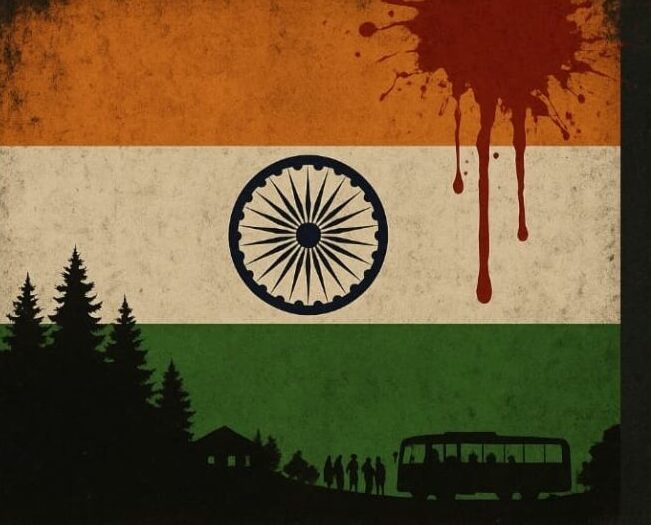Pahalgam and the pattern: India’s false flag obsession exposed
The recent attack on tourists in Pahalgam, located in Indian Illegally Occupied Jammu & Kashmir (IIOJK), has once again triggered a predictable media and political reaction from India: immediate blame on Pakistan.
No evidence, no investigation—just the same knee-jerk response that’s been used time and again to serve a larger political agenda. It’s not just a media tactic anymore; it has evolved into a dangerous script—a hybrid warfare playbook used to demonize Pakistan, distract from domestic failures, and manipulate public opinion, especially during election seasons.
This isn’t paranoia—it’s pattern recognition.
India’s false flag operations follow a now-transparent formula. Stage an attack—preferably in Kashmir or near a sensitive time (like elections or foreign visits)—and then unleash a media frenzy pinning it on Pakistan. It garners international sympathy, silences dissent at home, and consolidates votes based on fear and nationalism.
Take the recent Pahalgam incident. It occurred during a time when the United States Vice President JD Vance was visiting the region. Coincidence? Not likely. The script is familiar: create chaos, draw international attention, and portray Pakistan as the villain on a global stage. But the timing is just too convenient to ignore.
Let’s revisit some notable incidents where the truth, when eventually uncovered, stood in stark contrast to the Indian narrative:
Samjhauta Express (2007)
Sixty-eight people, mostly Pakistanis, were killed in a devastating train blast. India swiftly blamed Pakistan. However, years later, the investigation pointed to Hindu extremist groups. Indian Army officer Lt. Col. Purohit and other radical elements were arrested. This wasn’t Pakistan’s doing—it was terrorism from within.
Mumbai Attacks (2008)
Used as a defining event to isolate Pakistan internationally, the Mumbai attacks caused global outrage. But in 2013, former CBI officer Satish Verma revealed that India’s own agencies had orchestrated the attack to push draconian counter-terror laws. If this is true, it’s not just criminal—it’s treasonous.
Kerala Tourists Attack (2018)
On April 31, just before key elections in Kerala, Madhya Pradesh, and Rajasthan, tourists from Kerala were attacked in IOK. It was brushed off as another “Pakistan-backed” incident. But the political timing was too precise to ignore. Coincidentally, Modi’s party, the BJP, was under pressure then too.
Pulwama (2019)
One of the most notorious incidents, where 40 Indian soldiers were killed. Modi’s government instantly blamed Pakistan without an inquiry. Later, Satya Pal Malik, the former governor of IIOJK, blew the whistle—alleging that the attack was due to internal failures and a “staged plan” to gain electoral leverage. What followed was a military escalation that nearly led to war—all built on a lie.
Rajouri (2023)
Five Indian soldiers died during a period when Modi was actively campaigning. The attack seamlessly fit into BJP’s divisive narrative against Muslims and Pakistan. No transparency. No real inquiry. Just another story used to polarize voters and push the Hindutva agenda.
Pahalgam (2025)
And now, we see it again. Tourists attacked, and without even waiting for forensic evidence, fingers were pointed at Pakistan. Mubasher Lucman rightly mocked this haste in his tweet, pointing out how Indian media appeared to be “ready to blame” even before the dust settled. In a region with 700,000 Indian troops—a soldier for every 7 civilians—it’s implausible for such attacks to happen without internal collusion.
Why these tactics persist?
The answer is simple: they work. These operations allow India’s ruling party to: stoke nationalism and suppress dissent; blame external enemies instead of addressing internal chaos; win elections using fear, not policy; justify increased militarization and human rights violations in Kashmir.
But the consequences are grave. Lives are lost. Peace is derailed. And regional stability is constantly under threat—all to serve a manufactured narrative.
IIOJK is one of the most militarized zones in the world. With drones, checkposts, surveillance, and a soldier practically on every corner, how do attackers consistently breach security? Either the system is utterly incompetent, or it is complicit. There’s no third option. And the answer becomes clearer with each new “incident.”
Pakistan has repeatedly called for independent investigations into these attacks, often suggesting joint inquiries. India has refused every time. Why? If the truth is on India’s side, wouldn’t transparency help?
Instead, India doubles down on propaganda—fuelled by a biased media and emboldened by the silence of international allies.
The Pahalgam attack is not an isolated case—it’s a chapter in a long book of false flag operations. Until the global community demands accountability and truth, this pattern will persist. The real victims are not just those who die in these attacks—but the peace that continues to elude South Asia.
It’s time to stop treating India’s accusations as gospel. The world needs to look beyond the headlines and recognize the strategy behind the story.



